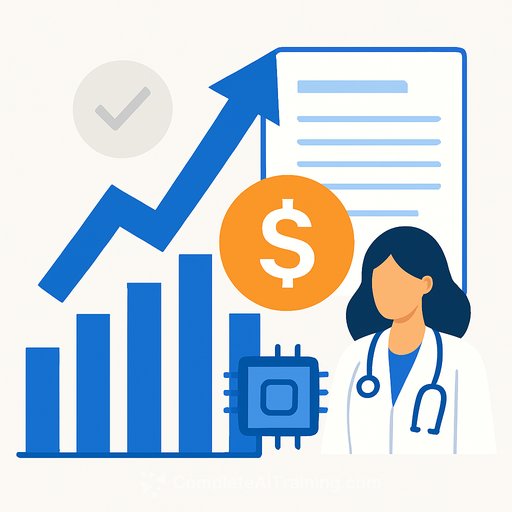Tempus AI (TEM) Stock Skyrockets on AI Healthcare Breakthroughs - What Healthcare Leaders Need to Know
Tempus AI, Inc. (NASDAQ: TEM) is building a healthcare operating system that turns clinical and molecular data into actionable insights. Founded in 2015 by Eric Lefkofsky, the company spans oncology, cardiology, radiology, and hereditary testing with AI-driven diagnostics and analytics.
With new FDA clearances, major data assets, and fast revenue growth, Tempus is gaining traction across clinics and health systems. Here's what matters for clinicians, service line leaders, and hospital executives evaluating AI in care delivery.
Why this matters for care delivery
- Clinical utility: FDA-cleared AI and advanced sequencing can sharpen diagnosis, therapy selection, and trial matching.
- Workflow impact: Genomic reports, imaging AI, and an EHR-side clinical assistant aim to reduce friction at the point of care.
- System-level value: Quality, throughput, and precision can improve when multimodal data feeds the same platform.
Company and mission
Tempus is focused on precision medicine: ingest data at scale, apply AI, and return decisions that help real patients. The company operates large sequencing programs and one of the largest de-identified datasets spanning genomic, clinical, radiology, and pathology data.
The goal: make clinical and molecular data useful in routine care. Advisory ties and investor backing from leading tech and biotech circles reflect the push to bring AI into mainstream oncology and beyond.
Business model and AI platform
Tempus blends data generation with analytics. More clinical testing creates more data, which trains better models, which drives more clinical and pharma demand.
- Genomic and diagnostic testing: High-volume DNA/RNA sequencing for oncology and hereditary risk; testing also extends into cardiology and neurology.
- Data, AI, and services: Decision-support tools for clinicians, trial-matching software, and data licensing to pharma for R&D.
- Tempus One: A generative AI clinical assistant integrated with EHRs to answer provider questions and surface relevant patient insights.
- Imaging AI (Pixel): FDA-cleared cardiac MRI analysis that can auto-generate T1/T2 maps for heart disease assessment.
- Multimodal foundation models: Models trained on genomics, imaging, pathology, and clinical notes-accelerated by the acquisition of Paige and its large pathology image archive.
Latest news moving the stock
In September 2025, Tempus secured FDA 510(k) clearance for two products: the Tempus xR RNA sequencing test for tumor genomics and an updated Tempus Pixel platform for cardiac imaging. It also folded breast density analytics into its hereditary cancer risk model via Ambry Genetics to refine screening.
The August 2025 acquisition of Paige added ~7 million pathology images to boost oncology models. Q2 results topped expectations and management raised full-year guidance, helping drive the recent rally. Learn more about 510(k) clearances from the FDA here.
Financial snapshot (2025 YTD)
- Revenue growth: Q1 2025 revenue of ~$255.7M (+75% YoY); Q2 2025 revenue of ~$314.6M (+89.6% YoY). Trailing 12-month revenue around ~$693M.
- Profit path: Q2 net loss of $0.22 per share (better than expected); full-year 2025 guide calls for positive adjusted EBITDA (~$5M).
- Margins: Gross margin ~62% in Q2; losses narrowing with scale and volume.
- Valuation context: At ~$102 per share (Oct 8), market cap is ~$16-17B; Price/Sales near ~13 on 2025 guidance.
Stock performance
TEM went public in June 2024 at ~$21 and rose 9% on day one. Through 2025 the shares climbed on strong results and product news.
On October 8, 2025, the stock closed around $102.31, up nearly 10% on the day and near all-time highs. Year-to-date, the stock is up roughly 190%, with buying interest clustering around major announcements and guidance updates.
Partnerships and clients
- More than half of U.S. oncologists use Tempus tools or services.
- Exclusive marketing rights with Personalis for a colorectal cancer MRD test through 2028.
- Northwestern Medicine is the first health system to integrate Tempus One into its EHR for clinician support.
- Global expansion via a SoftBank joint venture in Japan and the Ambry Genetics acquisition in late 2024.
Competitive context
Competitors span genomics (Illumina/Grail), data and analytics (Roche's Flatiron Health, Foundation Medicine), liquid biopsy (Guardant Health, Natera), and AI diagnostics startups. Large tech firms remain active in healthcare AI. Tempus's advantage centers on data scale, vertical integration (lab plus software), and growing FDA-cleared products.
What healthcare leaders should watch
- Clinical impact: Do AI reports shift therapeutic choices, reduce time-to-treatment, or lift outcomes and guideline adherence?
- Workflow fit: EHR integration quality, turnaround times, and clinician trust in AI recommendations.
- Regulatory momentum: Additional FDA clearances across imaging, genomics, and decision support.
- Reimbursement: Payer coverage for tests and AI-enabled services; implications for service line economics.
- Data partnerships: New pharma deals and academic collaborations that extend the dataset and model performance.
- Operating leverage: Path to sustained profitability while maintaining growth and quality.
Risks and execution challenges
- Valuation risk: Expectations are high; any slowdown or miss could swing the stock.
- Regulatory and compliance: Ongoing oversight for diagnostics and AI; privacy, security, and auditability are essential.
- Data quality and bias: Model performance depends on diverse, well-labeled, and current data.
- Competition: Incumbents and startups are investing heavily; payer and provider contracts are contested.
- Integration: M&A and EHR deployments require careful change management and clear clinical value.
Actionable steps for providers and health systems
- Pilot with clear endpoints: Start in one tumor type or service line; measure time-to-result, therapy changes, and outcome deltas.
- Standardize intake: Tighten specimen workflows and data capture to improve report quality and turnaround.
- Governance: Establish an AI oversight group to review performance, fairness, and model updates.
- Clinician enablement: Provide short training on interpreting genomic reports and AI outputs; integrate into care pathways.
- Security and compliance: Validate de-identification, audit logging, and vendor controls before scaling.
Analyst sentiment and outlook
Sell-side views are constructive with recent price targets in the mid-to-high $90s following FDA wins and strong volumes. Bulls point to 2025 revenue guidance of ~$1.26B, a turn to positive EBITDA, and potential for sustained 40-50% growth from a larger base.
Skeptics focus on valuation and the need to deliver earnings. For healthcare operators, the immediate question is simpler: does Tempus improve care quality and costs enough to standardize across your network?
Bottom line
Tempus is pushing AI deeper into clinical workflows with FDA-cleared tools, a large multimodal dataset, and accelerating adoption. If the company continues to pair strong clinical utility with operational reliability, expect broader use across oncology and cardiology service lines-and faster learning loops between the lab, clinic, and research.
If you're building internal capability around AI in care delivery, explore practical training by role here: Complete AI Training - Courses by Job.
Your membership also unlocks:






